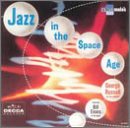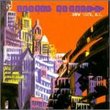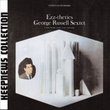| All Artists: George Russell Title: Jazz in the Space Age Members Wishing: 1 Total Copies: 0 Label: Grp Records Release Date: 5/19/1998 Genres: Jazz, Pop Styles: Avant Garde & Free Jazz, Modern Postbebop, Bebop Number of Discs: 1 SwapaCD Credits: 1 UPC: 011105082624 |
Search - George Russell :: Jazz in the Space Age
 | George Russell Jazz in the Space Age Genres: Jazz, Pop
|
Larger Image |
CD DetailsSimilar CDs
|
CD ReviewsA highpoint of postwar jazz N. Dorward | Toronto, ON Canada | 11/19/2000 (5 out of 5 stars) "This album is positioned at a watershed in George Russell's career. It represents the peak of his early "arranger's albums", in which Russell assembled a large & stellar cast of musicians (typically, as here, pinned on a number of stalwarts: the pianist Bill Evans, the bassist Milt Hinton, the guitarist Barry Galbraith, the alto player Hal McKusick) to play his formidably complex charts. Russell does not play on the album beyond contributing the eerie percussion opening to "Chromatic Universe", running a string of beads over tuned drums. Russell was after this album to change his approach, as reflected in _Live at the Five Spot_ & the Riverside albums: there he led a small jazz combo with himself at the piano, & pared back the complexity of his charts in a way similar to Gil Evans when he became a regular bandleader.The album is divided between a series of three short "Chromatic Universe" tracks and three longer pieces. The "Chromatic Universe" tracks are features for the duelling pianos of Bill Evans & Paul Bley, one of the most memorable encounters in modern jazz. They play together against a tricky 5/2 rhythm-section backdrop, one which maximises the soloists' freedom: these tracks are in fact probably the closest Evans ever got to "free jazz". -- The three longer tracks feature charts that are meticulously detailed, with the characteristic off-centre polyphonic fanfares of Russell's early work. There's fine work from lesser-known players like Al Kiger & David Young, but the centrepiece is again a piano battle between Evans & Bley on "The Lydiot"--this time, not a simultaneous improvisation but trading fours.This is a recording both enjoyable & historically significant. With _Ezz-Thetic_ & the Jazz Workshop date it's one of the peaks in Russell's oeuvre." Not Just a Theorist Christopher Forbes | Brooklyn,, NY | 08/30/2002 (5 out of 5 stars) "George Russell is probably the most influential jazz musicians that you've never heard of! If you are a musician, you may know him from his exceptional, and exceptionally difficult treatise on jazz theory "The Lydian Chromatic Concept"....but this theory, watered down and simplified, has been passed on to innumerable young jazzers educated at the Berklee School, in the theory of "chord scales". These chord scale theories are fine as far as they go, but Russell's concept goes farther and deeper.All of this would be well and good, but should be judged by the results, and the results on this CD are spectacular. Russell's music is both gripping and complex. The CD is a suite, not a set of pieces. There are melodic and rhythmic corrospndences in each of the movements. And Russell's writing is so flexible that there are moments where the transitions from improvisation to composition are completely seemless. The playing in the orchestra is crisp and precise, rivaling the work of the Kenton band of the time, but pushing the envelope even more. Part of the reason to get this CD is to listen to the duo piano work of Bill Evans and Paul Bley. Evans is as adventurous on this album as he ever got...(except on Russell's Living Time album which is an extension of the concepts explored here) and he and Bley listen intently to each other. The results are spectacular! There is also fine soloing by David Young and especially a young David Baker.Many of the musicians on this album ended up going down different paths. Bley became the lyric voice of the avant-garde, Evans, a neo-traditional romantic, Baker, a jazz educator of the first degree. But what is evident here is that Russell taught them much more than has ever been ackowledged....and is himself a genuine creative artist. Here's hoping that his masterwork (Othello, a ballet for big band that Russell recorded in the late 60s) will someday be available again. Until then, this CD is a treasure. Buy it and be amazed."
|

 Track Listings (6) - Disc #1
Track Listings (6) - Disc #1

